BBA (HRM) HRM3402 Staffing Organization Report Assignment
VerifiedAdded on 2021/04/07
|21
|5503
|53
Report
AI Summary
This report, prepared for a Bachelor of Business Administration (Human Resources Management) program, delves into the core concepts of staffing organizations. It begins by defining and discussing the purposes of orientation, differentiating between formal and informal approaches. The report then explores performance appraisal, outlining its uses and examining four key methods: Management by Objectives (MBO), Assessment Centre Method, Behaviorally Anchored Rating Scale (BARS), and Human-Resource (Cost) Accounting Method. Furthermore, it analyzes career planning and development, detailing their purposes for both organizations and individuals. The second part of the report examines the impact of the COVID-19 pandemic on unemployment rates in Thailand and recommends recruitment strategies for the recruitment industry during the outbreak. The report also discusses the effects of the pandemic on different types of employees, including full-time, timed contractors, and temporary employees. Finally, it explores the pros and cons of online recruitment methods and highlights the importance of communication and leadership in the recruitment process.
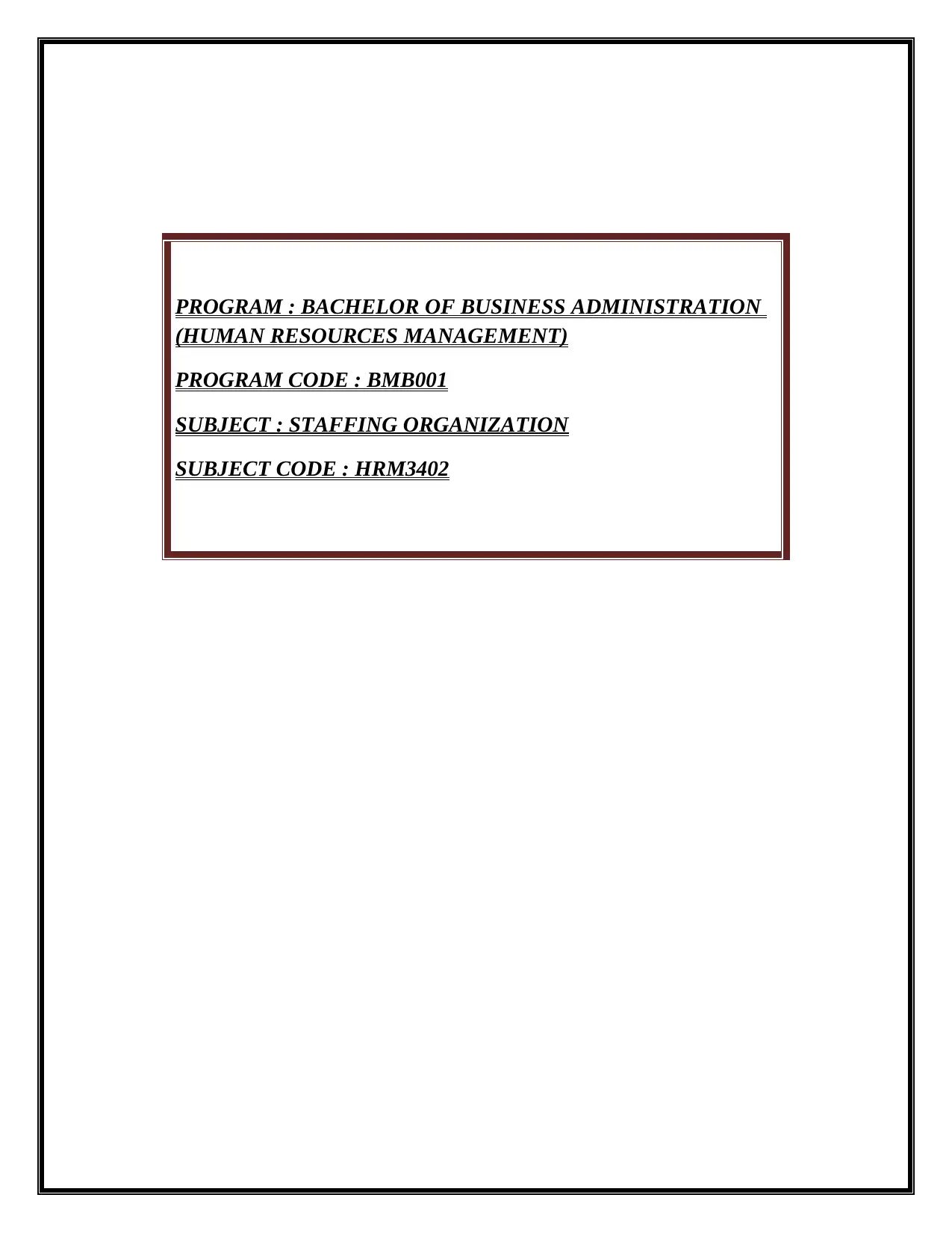
PROGRAM : BACHELOR OF BUSINESS ADMINISTRATION
(HUMAN RESOURCES MANAGEMENT)
PROGRAM CODE : BMB001
SUBJECT : STAFFING ORGANIZATION
SUBJECT CODE : HRM3402
(HUMAN RESOURCES MANAGEMENT)
PROGRAM CODE : BMB001
SUBJECT : STAFFING ORGANIZATION
SUBJECT CODE : HRM3402
Paraphrase This Document
Need a fresh take? Get an instant paraphrase of this document with our AI Paraphraser
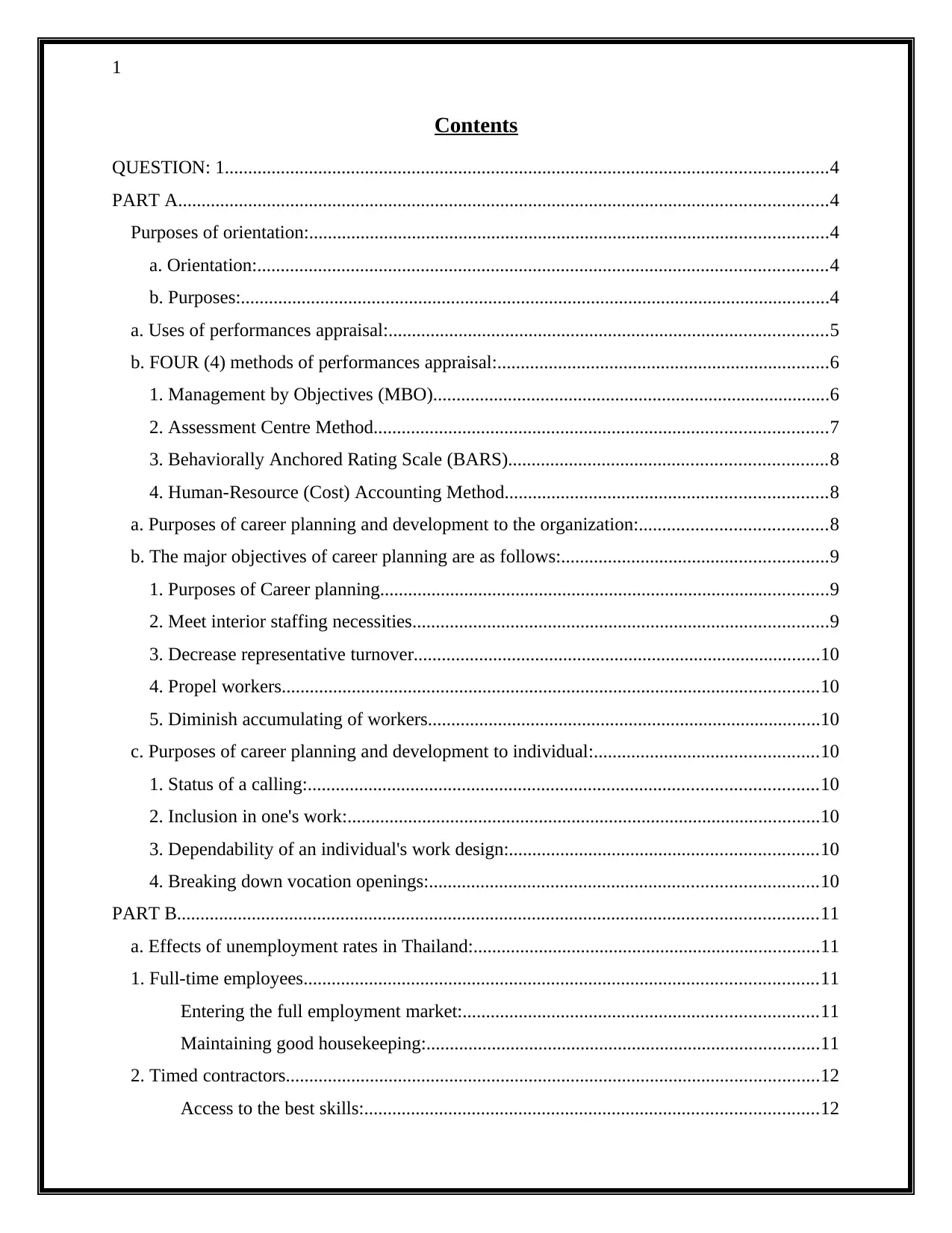
1
Contents
QUESTION: 1.................................................................................................................................4
PART A...........................................................................................................................................4
Purposes of orientation:...............................................................................................................4
a. Orientation:..........................................................................................................................4
b. Purposes:..............................................................................................................................4
a. Uses of performances appraisal:..............................................................................................5
b. FOUR (4) methods of performances appraisal:.......................................................................6
1. Management by Objectives (MBO).....................................................................................6
2. Assessment Centre Method.................................................................................................7
3. Behaviorally Anchored Rating Scale (BARS)....................................................................8
4. Human-Resource (Cost) Accounting Method.....................................................................8
a. Purposes of career planning and development to the organization:........................................8
b. The major objectives of career planning are as follows:.........................................................9
1. Purposes of Career planning................................................................................................9
2. Meet interior staffing necessities.........................................................................................9
3. Decrease representative turnover.......................................................................................10
4. Propel workers...................................................................................................................10
5. Diminish accumulating of workers....................................................................................10
c. Purposes of career planning and development to individual:................................................10
1. Status of a calling:.............................................................................................................10
2. Inclusion in one's work:.....................................................................................................10
3. Dependability of an individual's work design:..................................................................10
4. Breaking down vocation openings:...................................................................................10
PART B.........................................................................................................................................11
a. Effects of unemployment rates in Thailand:..........................................................................11
1. Full-time employees..............................................................................................................11
Entering the full employment market:............................................................................11
Maintaining good housekeeping:....................................................................................11
2. Timed contractors..................................................................................................................12
Access to the best skills:.................................................................................................12
Contents
QUESTION: 1.................................................................................................................................4
PART A...........................................................................................................................................4
Purposes of orientation:...............................................................................................................4
a. Orientation:..........................................................................................................................4
b. Purposes:..............................................................................................................................4
a. Uses of performances appraisal:..............................................................................................5
b. FOUR (4) methods of performances appraisal:.......................................................................6
1. Management by Objectives (MBO).....................................................................................6
2. Assessment Centre Method.................................................................................................7
3. Behaviorally Anchored Rating Scale (BARS)....................................................................8
4. Human-Resource (Cost) Accounting Method.....................................................................8
a. Purposes of career planning and development to the organization:........................................8
b. The major objectives of career planning are as follows:.........................................................9
1. Purposes of Career planning................................................................................................9
2. Meet interior staffing necessities.........................................................................................9
3. Decrease representative turnover.......................................................................................10
4. Propel workers...................................................................................................................10
5. Diminish accumulating of workers....................................................................................10
c. Purposes of career planning and development to individual:................................................10
1. Status of a calling:.............................................................................................................10
2. Inclusion in one's work:.....................................................................................................10
3. Dependability of an individual's work design:..................................................................10
4. Breaking down vocation openings:...................................................................................10
PART B.........................................................................................................................................11
a. Effects of unemployment rates in Thailand:..........................................................................11
1. Full-time employees..............................................................................................................11
Entering the full employment market:............................................................................11
Maintaining good housekeeping:....................................................................................11
2. Timed contractors..................................................................................................................12
Access to the best skills:.................................................................................................12
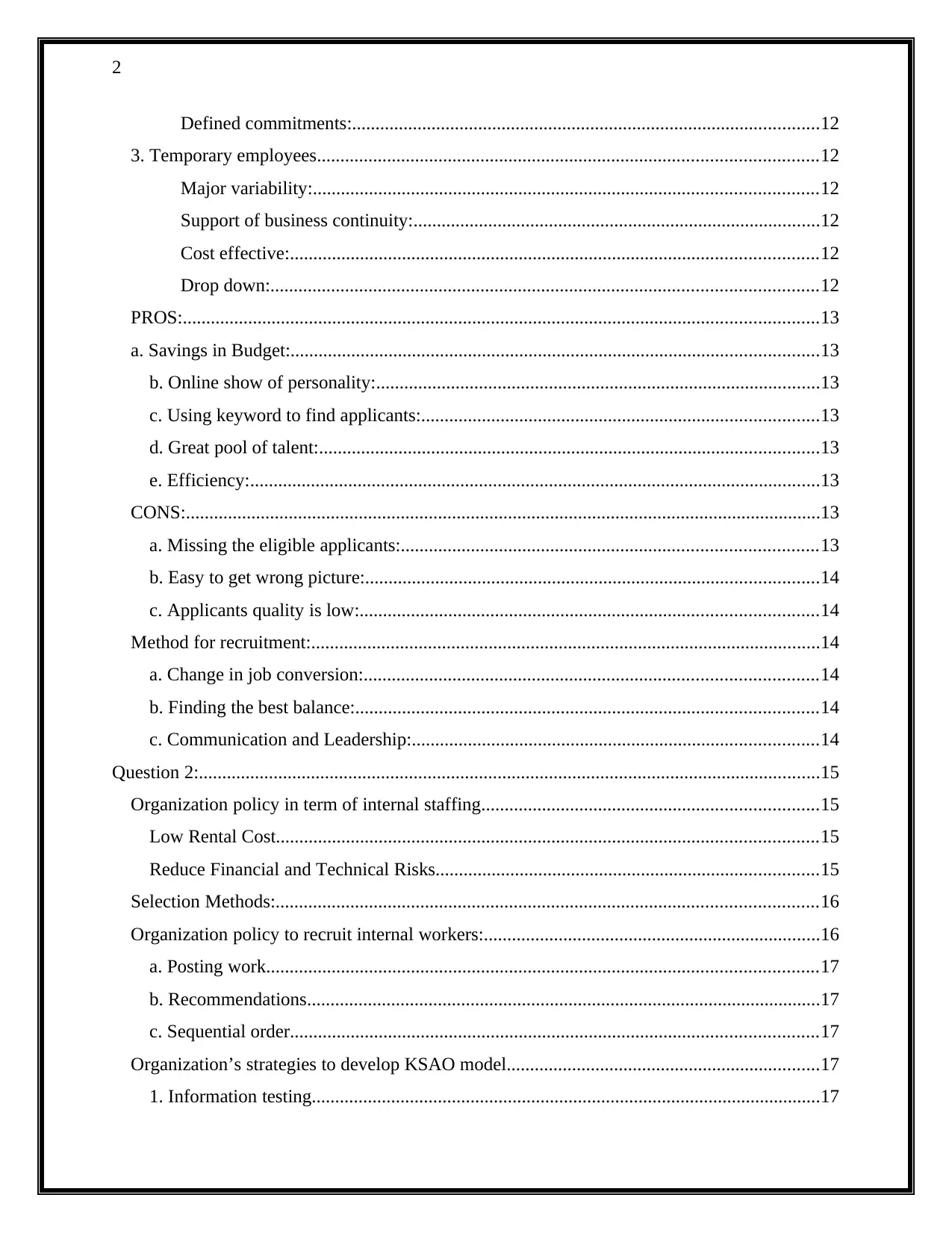
2
Defined commitments:....................................................................................................12
3. Temporary employees...........................................................................................................12
Major variability:............................................................................................................12
Support of business continuity:.......................................................................................12
Cost effective:.................................................................................................................12
Drop down:.....................................................................................................................12
PROS:........................................................................................................................................13
a. Savings in Budget:.................................................................................................................13
b. Online show of personality:...............................................................................................13
c. Using keyword to find applicants:.....................................................................................13
d. Great pool of talent:...........................................................................................................13
e. Efficiency:..........................................................................................................................13
CONS:........................................................................................................................................13
a. Missing the eligible applicants:.........................................................................................13
b. Easy to get wrong picture:.................................................................................................14
c. Applicants quality is low:..................................................................................................14
Method for recruitment:.............................................................................................................14
a. Change in job conversion:.................................................................................................14
b. Finding the best balance:...................................................................................................14
c. Communication and Leadership:.......................................................................................14
Question 2:.....................................................................................................................................15
Organization policy in term of internal staffing........................................................................15
Low Rental Cost....................................................................................................................15
Reduce Financial and Technical Risks..................................................................................15
Selection Methods:....................................................................................................................16
Organization policy to recruit internal workers:........................................................................16
a. Posting work......................................................................................................................17
b. Recommendations..............................................................................................................17
c. Sequential order.................................................................................................................17
Organization’s strategies to develop KSAO model...................................................................17
1. Information testing.............................................................................................................17
Defined commitments:....................................................................................................12
3. Temporary employees...........................................................................................................12
Major variability:............................................................................................................12
Support of business continuity:.......................................................................................12
Cost effective:.................................................................................................................12
Drop down:.....................................................................................................................12
PROS:........................................................................................................................................13
a. Savings in Budget:.................................................................................................................13
b. Online show of personality:...............................................................................................13
c. Using keyword to find applicants:.....................................................................................13
d. Great pool of talent:...........................................................................................................13
e. Efficiency:..........................................................................................................................13
CONS:........................................................................................................................................13
a. Missing the eligible applicants:.........................................................................................13
b. Easy to get wrong picture:.................................................................................................14
c. Applicants quality is low:..................................................................................................14
Method for recruitment:.............................................................................................................14
a. Change in job conversion:.................................................................................................14
b. Finding the best balance:...................................................................................................14
c. Communication and Leadership:.......................................................................................14
Question 2:.....................................................................................................................................15
Organization policy in term of internal staffing........................................................................15
Low Rental Cost....................................................................................................................15
Reduce Financial and Technical Risks..................................................................................15
Selection Methods:....................................................................................................................16
Organization policy to recruit internal workers:........................................................................16
a. Posting work......................................................................................................................17
b. Recommendations..............................................................................................................17
c. Sequential order.................................................................................................................17
Organization’s strategies to develop KSAO model...................................................................17
1. Information testing.............................................................................................................17
⊘ This is a preview!⊘
Do you want full access?
Subscribe today to unlock all pages.

Trusted by 1+ million students worldwide
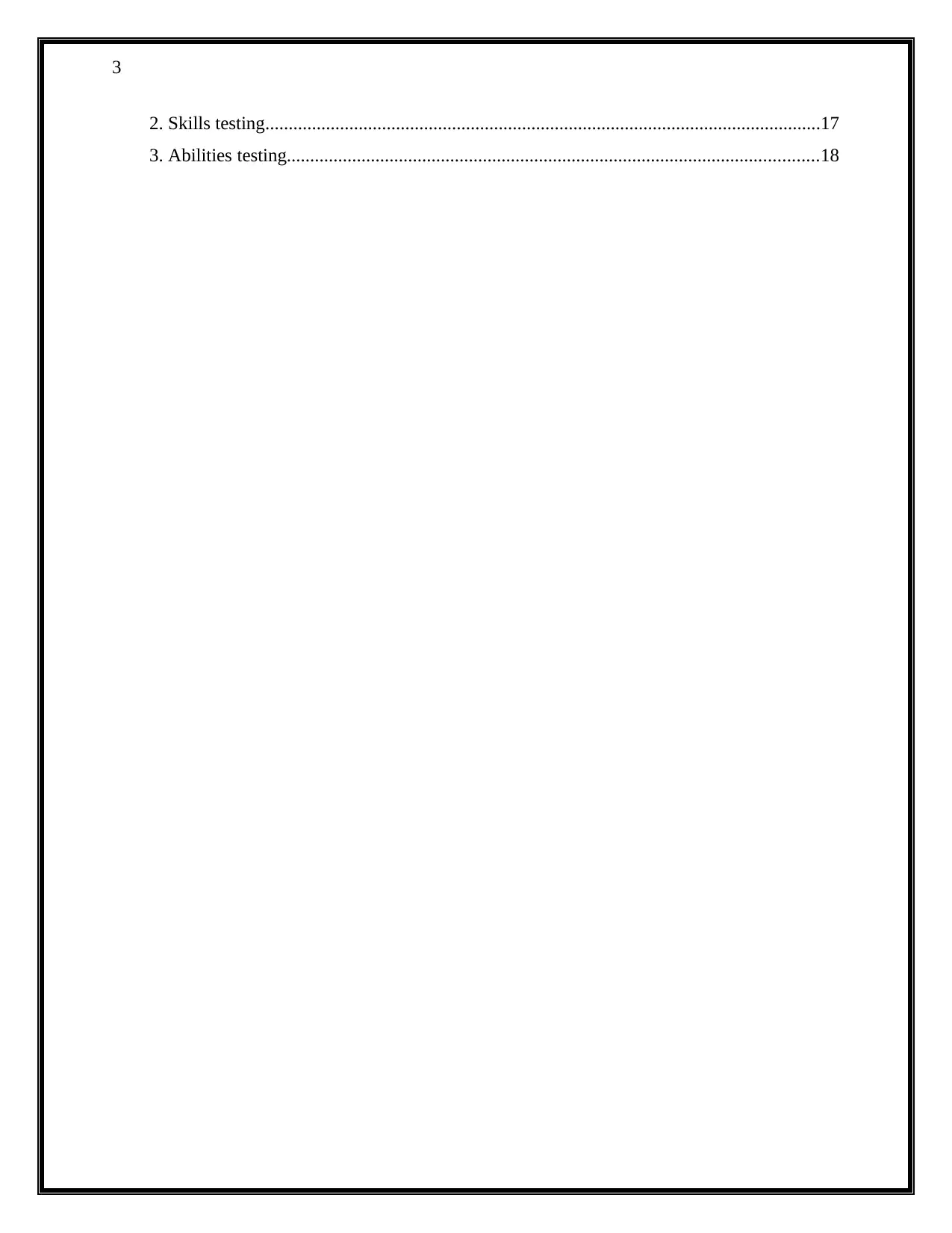
3
2. Skills testing.......................................................................................................................17
3. Abilities testing..................................................................................................................18
2. Skills testing.......................................................................................................................17
3. Abilities testing..................................................................................................................18
Paraphrase This Document
Need a fresh take? Get an instant paraphrase of this document with our AI Paraphraser
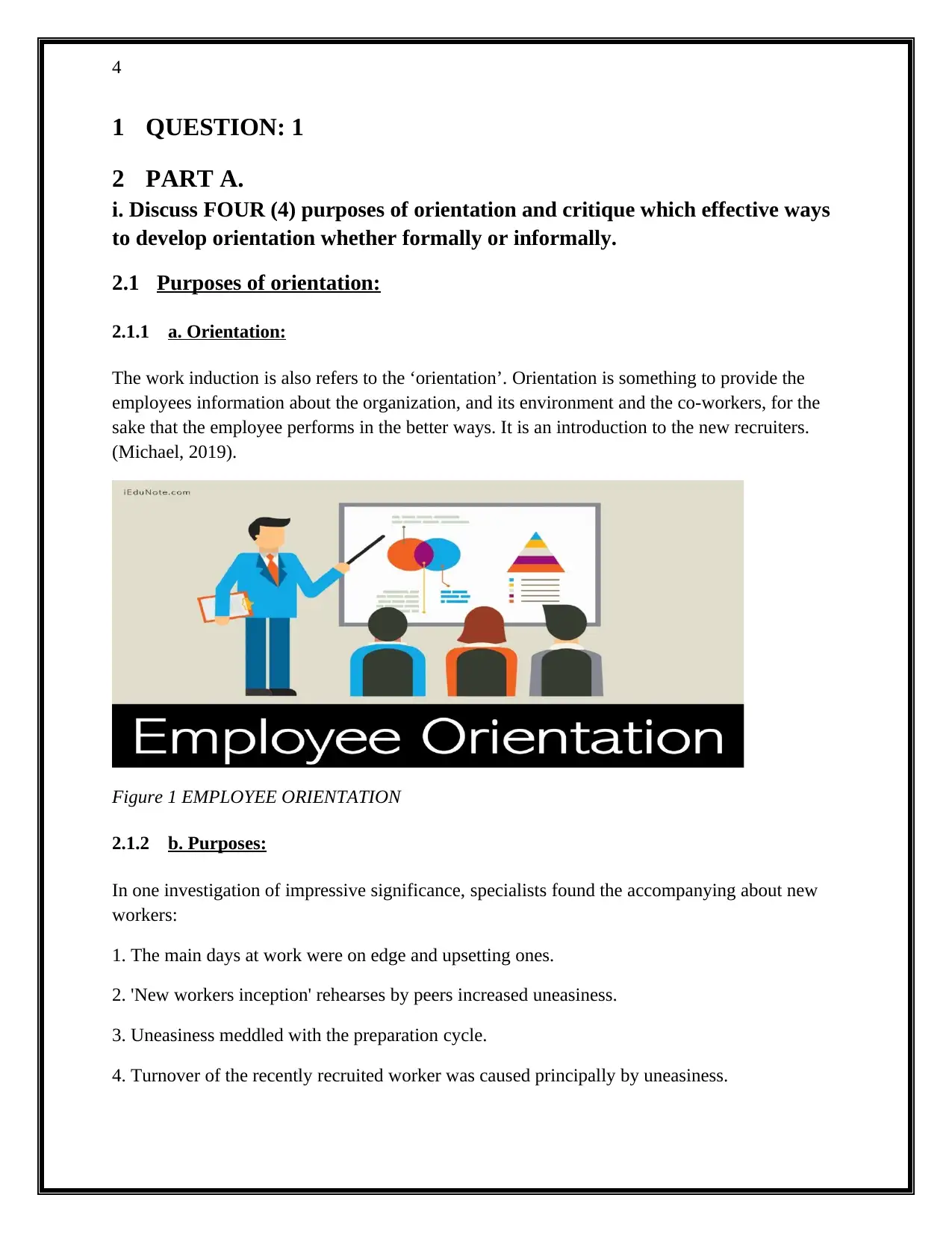
4
1 QUESTION: 1
2 PART A.
i. Discuss FOUR (4) purposes of orientation and critique which effective ways
to develop orientation whether formally or informally.
2.1 Purposes of orientation:
2.1.1 a. Orientation:
The work induction is also refers to the ‘orientation’. Orientation is something to provide the
employees information about the organization, and its environment and the co-workers, for the
sake that the employee performs in the better ways. It is an introduction to the new recruiters.
(Michael, 2019).
Figure 1 EMPLOYEE ORIENTATION
2.1.2 b. Purposes:
In one investigation of impressive significance, specialists found the accompanying about new
workers:
1. The main days at work were on edge and upsetting ones.
2. 'New workers inception' rehearses by peers increased uneasiness.
3. Uneasiness meddled with the preparation cycle.
4. Turnover of the recently recruited worker was caused principally by uneasiness.
1 QUESTION: 1
2 PART A.
i. Discuss FOUR (4) purposes of orientation and critique which effective ways
to develop orientation whether formally or informally.
2.1 Purposes of orientation:
2.1.1 a. Orientation:
The work induction is also refers to the ‘orientation’. Orientation is something to provide the
employees information about the organization, and its environment and the co-workers, for the
sake that the employee performs in the better ways. It is an introduction to the new recruiters.
(Michael, 2019).
Figure 1 EMPLOYEE ORIENTATION
2.1.2 b. Purposes:
In one investigation of impressive significance, specialists found the accompanying about new
workers:
1. The main days at work were on edge and upsetting ones.
2. 'New workers inception' rehearses by peers increased uneasiness.
3. Uneasiness meddled with the preparation cycle.
4. Turnover of the recently recruited worker was caused principally by uneasiness.
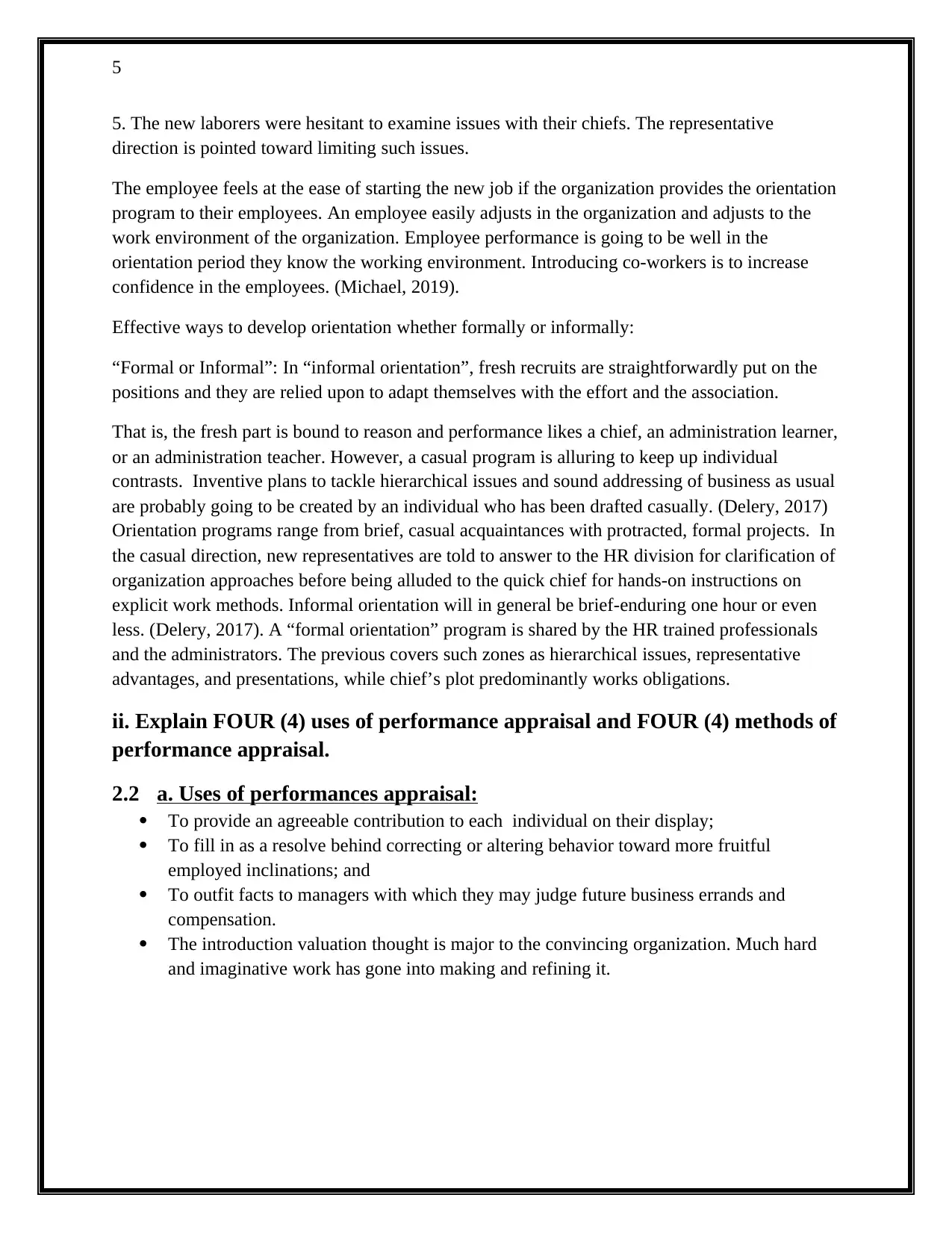
5
5. The new laborers were hesitant to examine issues with their chiefs. The representative
direction is pointed toward limiting such issues.
The employee feels at the ease of starting the new job if the organization provides the orientation
program to their employees. An employee easily adjusts in the organization and adjusts to the
work environment of the organization. Employee performance is going to be well in the
orientation period they know the working environment. Introducing co-workers is to increase
confidence in the employees. (Michael, 2019).
Effective ways to develop orientation whether formally or informally:
“Formal or Informal”: In “informal orientation”, fresh recruits are straightforwardly put on the
positions and they are relied upon to adapt themselves with the effort and the association.
That is, the fresh part is bound to reason and performance likes a chief, an administration learner,
or an administration teacher. However, a casual program is alluring to keep up individual
contrasts. Inventive plans to tackle hierarchical issues and sound addressing of business as usual
are probably going to be created by an individual who has been drafted casually. (Delery, 2017)
Orientation programs range from brief, casual acquaintances with protracted, formal projects. In
the casual direction, new representatives are told to answer to the HR division for clarification of
organization approaches before being alluded to the quick chief for hands-on instructions on
explicit work methods. Informal orientation will in general be brief-enduring one hour or even
less. (Delery, 2017). A “formal orientation” program is shared by the HR trained professionals
and the administrators. The previous covers such zones as hierarchical issues, representative
advantages, and presentations, while chief’s plot predominantly works obligations.
ii. Explain FOUR (4) uses of performance appraisal and FOUR (4) methods of
performance appraisal.
2.2 a. Uses of performances appraisal:
To provide an agreeable contribution to each individual on their display;
To fill in as a resolve behind correcting or altering behavior toward more fruitful
employed inclinations; and
To outfit facts to managers with which they may judge future business errands and
compensation.
The introduction valuation thought is major to the convincing organization. Much hard
and imaginative work has gone into making and refining it.
5. The new laborers were hesitant to examine issues with their chiefs. The representative
direction is pointed toward limiting such issues.
The employee feels at the ease of starting the new job if the organization provides the orientation
program to their employees. An employee easily adjusts in the organization and adjusts to the
work environment of the organization. Employee performance is going to be well in the
orientation period they know the working environment. Introducing co-workers is to increase
confidence in the employees. (Michael, 2019).
Effective ways to develop orientation whether formally or informally:
“Formal or Informal”: In “informal orientation”, fresh recruits are straightforwardly put on the
positions and they are relied upon to adapt themselves with the effort and the association.
That is, the fresh part is bound to reason and performance likes a chief, an administration learner,
or an administration teacher. However, a casual program is alluring to keep up individual
contrasts. Inventive plans to tackle hierarchical issues and sound addressing of business as usual
are probably going to be created by an individual who has been drafted casually. (Delery, 2017)
Orientation programs range from brief, casual acquaintances with protracted, formal projects. In
the casual direction, new representatives are told to answer to the HR division for clarification of
organization approaches before being alluded to the quick chief for hands-on instructions on
explicit work methods. Informal orientation will in general be brief-enduring one hour or even
less. (Delery, 2017). A “formal orientation” program is shared by the HR trained professionals
and the administrators. The previous covers such zones as hierarchical issues, representative
advantages, and presentations, while chief’s plot predominantly works obligations.
ii. Explain FOUR (4) uses of performance appraisal and FOUR (4) methods of
performance appraisal.
2.2 a. Uses of performances appraisal:
To provide an agreeable contribution to each individual on their display;
To fill in as a resolve behind correcting or altering behavior toward more fruitful
employed inclinations; and
To outfit facts to managers with which they may judge future business errands and
compensation.
The introduction valuation thought is major to the convincing organization. Much hard
and imaginative work has gone into making and refining it.
⊘ This is a preview!⊘
Do you want full access?
Subscribe today to unlock all pages.

Trusted by 1+ million students worldwide
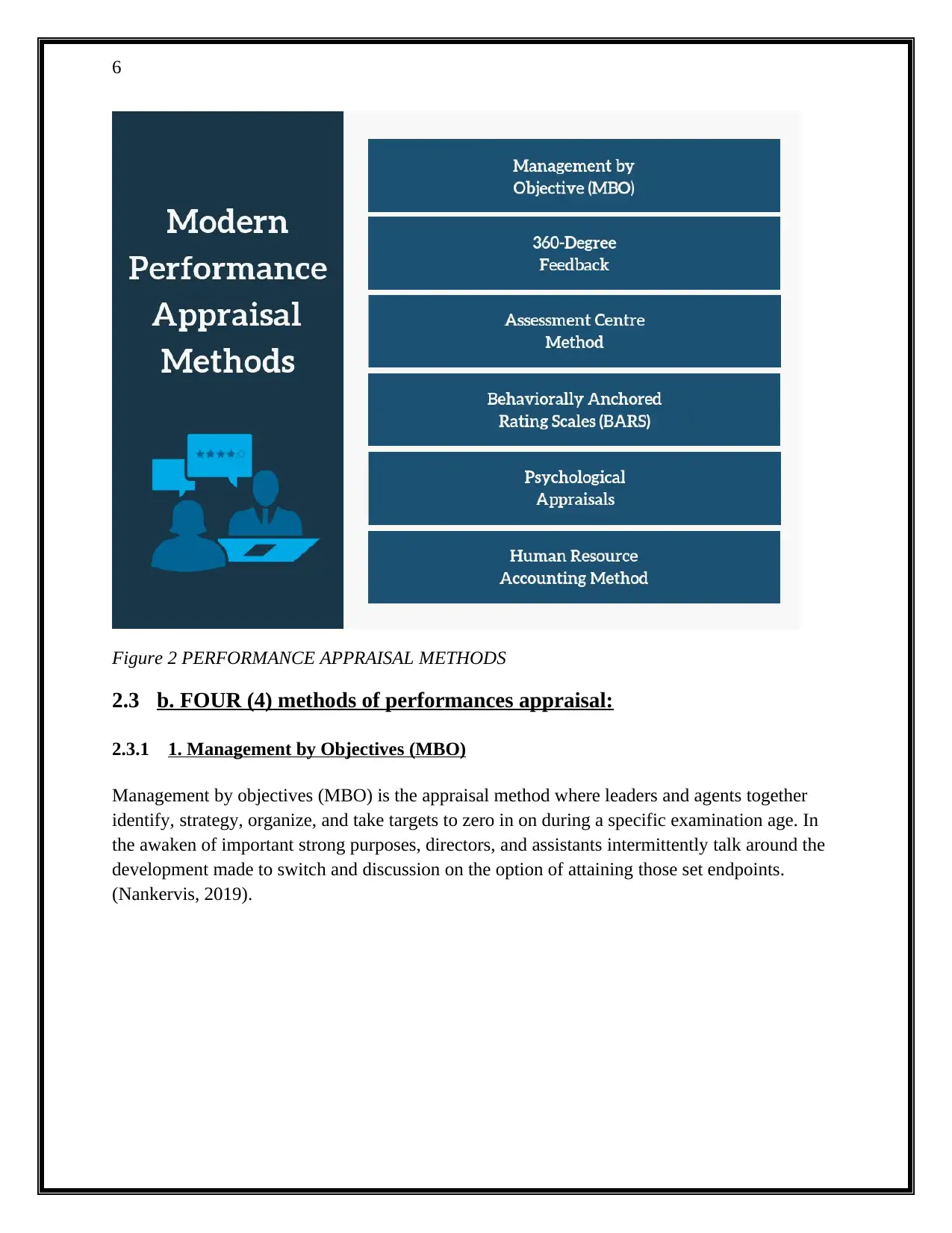
6
Figure 2 PERFORMANCE APPRAISAL METHODS
2.3 b. FOUR (4) methods of performances appraisal:
2.3.1 1. Management by Objectives (MBO)
Management by objectives (MBO) is the appraisal method where leaders and agents together
identify, strategy, organize, and take targets to zero in on during a specific examination age. In
the awaken of important strong purposes, directors, and assistants intermittently talk around the
development made to switch and discussion on the option of attaining those set endpoints.
(Nankervis, 2019).
Figure 2 PERFORMANCE APPRAISAL METHODS
2.3 b. FOUR (4) methods of performances appraisal:
2.3.1 1. Management by Objectives (MBO)
Management by objectives (MBO) is the appraisal method where leaders and agents together
identify, strategy, organize, and take targets to zero in on during a specific examination age. In
the awaken of important strong purposes, directors, and assistants intermittently talk around the
development made to switch and discussion on the option of attaining those set endpoints.
(Nankervis, 2019).
Paraphrase This Document
Need a fresh take? Get an instant paraphrase of this document with our AI Paraphraser
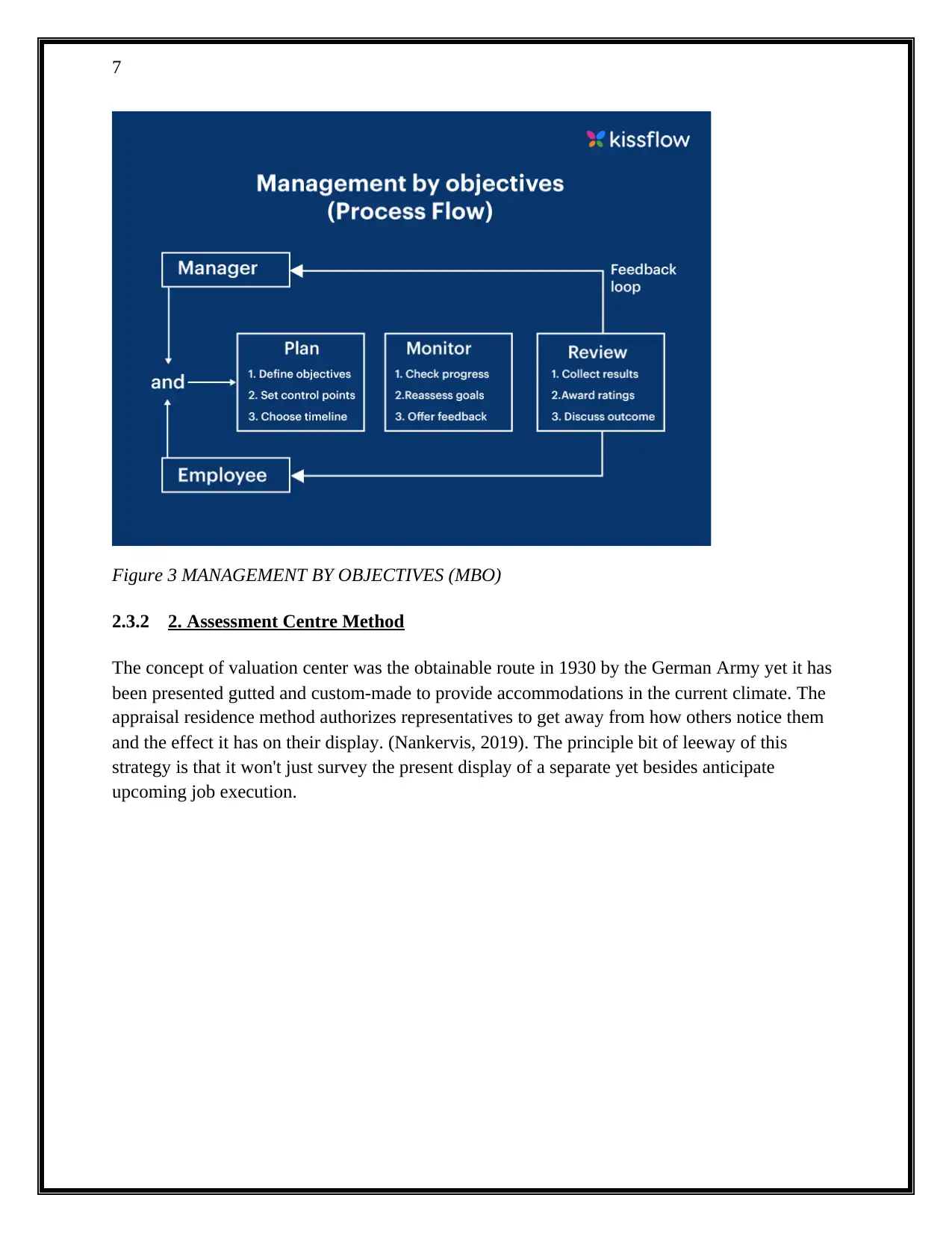
7
Figure 3 MANAGEMENT BY OBJECTIVES (MBO)
2.3.2 2. Assessment Centre Method
The concept of valuation center was the obtainable route in 1930 by the German Army yet it has
been presented gutted and custom-made to provide accommodations in the current climate. The
appraisal residence method authorizes representatives to get away from how others notice them
and the effect it has on their display. (Nankervis, 2019). The principle bit of leeway of this
strategy is that it won't just survey the present display of a separate yet besides anticipate
upcoming job execution.
Figure 3 MANAGEMENT BY OBJECTIVES (MBO)
2.3.2 2. Assessment Centre Method
The concept of valuation center was the obtainable route in 1930 by the German Army yet it has
been presented gutted and custom-made to provide accommodations in the current climate. The
appraisal residence method authorizes representatives to get away from how others notice them
and the effect it has on their display. (Nankervis, 2019). The principle bit of leeway of this
strategy is that it won't just survey the present display of a separate yet besides anticipate
upcoming job execution.
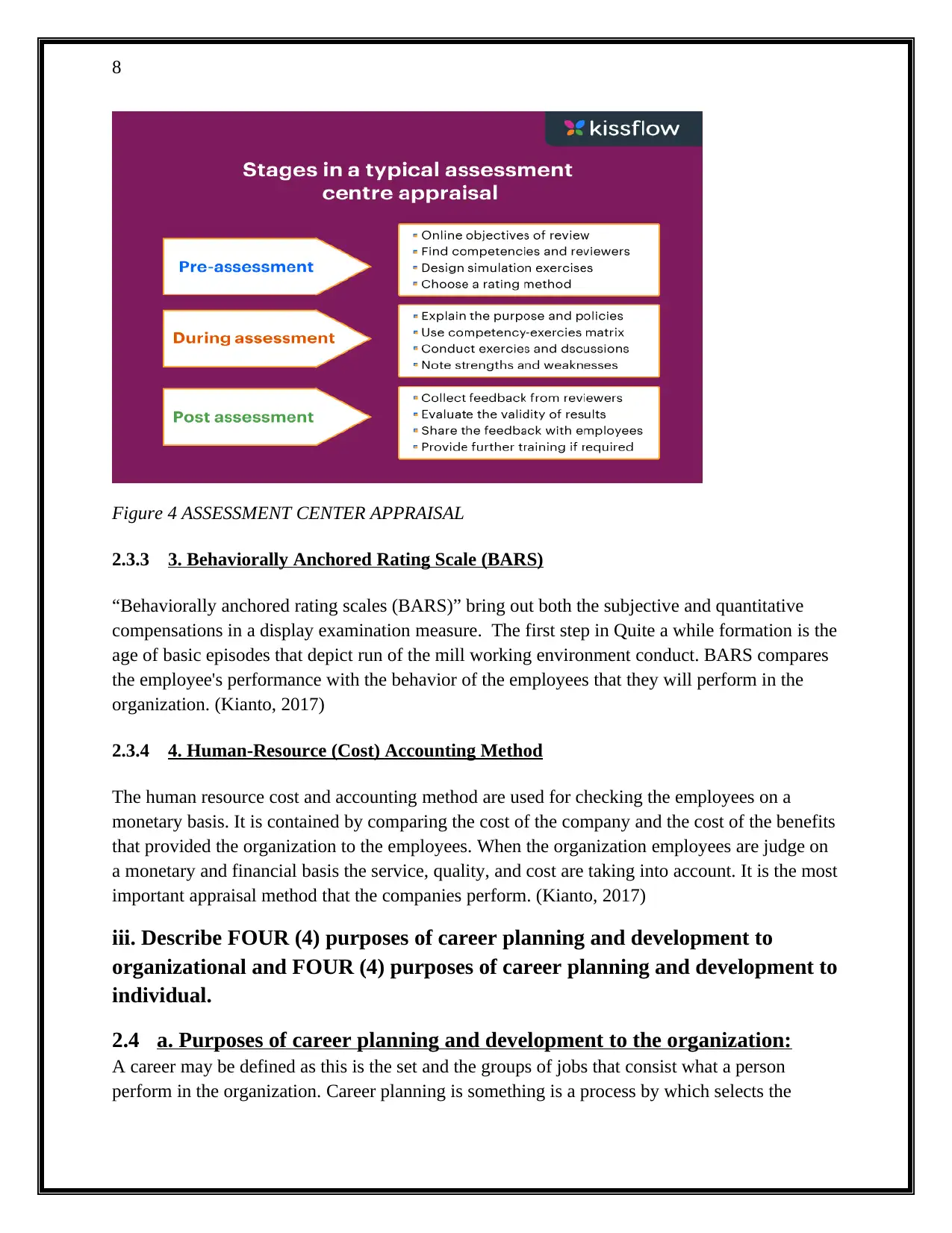
8
Figure 4 ASSESSMENT CENTER APPRAISAL
2.3.3 3. Behaviorally Anchored Rating Scale (BARS)
“Behaviorally anchored rating scales (BARS)” bring out both the subjective and quantitative
compensations in a display examination measure. The first step in Quite a while formation is the
age of basic episodes that depict run of the mill working environment conduct. BARS compares
the employee's performance with the behavior of the employees that they will perform in the
organization. (Kianto, 2017)
2.3.4 4. Human-Resource (Cost) Accounting Method
The human resource cost and accounting method are used for checking the employees on a
monetary basis. It is contained by comparing the cost of the company and the cost of the benefits
that provided the organization to the employees. When the organization employees are judge on
a monetary and financial basis the service, quality, and cost are taking into account. It is the most
important appraisal method that the companies perform. (Kianto, 2017)
iii. Describe FOUR (4) purposes of career planning and development to
organizational and FOUR (4) purposes of career planning and development to
individual.
2.4 a. Purposes of career planning and development to the organization:
A career may be defined as this is the set and the groups of jobs that consist what a person
perform in the organization. Career planning is something is a process by which selects the
Figure 4 ASSESSMENT CENTER APPRAISAL
2.3.3 3. Behaviorally Anchored Rating Scale (BARS)
“Behaviorally anchored rating scales (BARS)” bring out both the subjective and quantitative
compensations in a display examination measure. The first step in Quite a while formation is the
age of basic episodes that depict run of the mill working environment conduct. BARS compares
the employee's performance with the behavior of the employees that they will perform in the
organization. (Kianto, 2017)
2.3.4 4. Human-Resource (Cost) Accounting Method
The human resource cost and accounting method are used for checking the employees on a
monetary basis. It is contained by comparing the cost of the company and the cost of the benefits
that provided the organization to the employees. When the organization employees are judge on
a monetary and financial basis the service, quality, and cost are taking into account. It is the most
important appraisal method that the companies perform. (Kianto, 2017)
iii. Describe FOUR (4) purposes of career planning and development to
organizational and FOUR (4) purposes of career planning and development to
individual.
2.4 a. Purposes of career planning and development to the organization:
A career may be defined as this is the set and the groups of jobs that consist what a person
perform in the organization. Career planning is something is a process by which selects the
⊘ This is a preview!⊘
Do you want full access?
Subscribe today to unlock all pages.

Trusted by 1+ million students worldwide
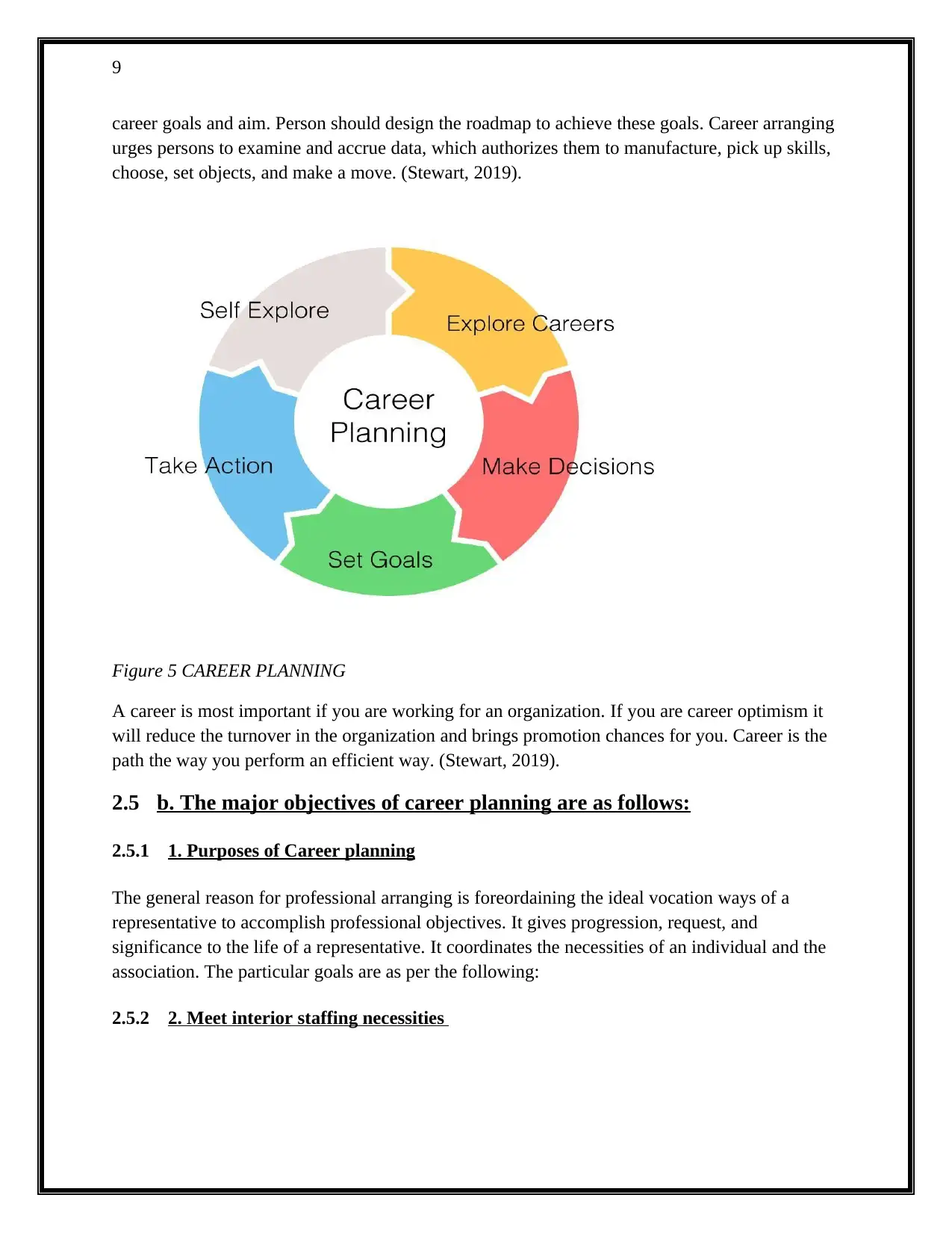
9
career goals and aim. Person should design the roadmap to achieve these goals. Career arranging
urges persons to examine and accrue data, which authorizes them to manufacture, pick up skills,
choose, set objects, and make a move. (Stewart, 2019).
Figure 5 CAREER PLANNING
A career is most important if you are working for an organization. If you are career optimism it
will reduce the turnover in the organization and brings promotion chances for you. Career is the
path the way you perform an efficient way. (Stewart, 2019).
2.5 b. The major objectives of career planning are as follows:
2.5.1 1. Purposes of Career planning
The general reason for professional arranging is foreordaining the ideal vocation ways of a
representative to accomplish professional objectives. It gives progression, request, and
significance to the life of a representative. It coordinates the necessities of an individual and the
association. The particular goals are as per the following:
2.5.2 2. Meet interior staffing necessities
career goals and aim. Person should design the roadmap to achieve these goals. Career arranging
urges persons to examine and accrue data, which authorizes them to manufacture, pick up skills,
choose, set objects, and make a move. (Stewart, 2019).
Figure 5 CAREER PLANNING
A career is most important if you are working for an organization. If you are career optimism it
will reduce the turnover in the organization and brings promotion chances for you. Career is the
path the way you perform an efficient way. (Stewart, 2019).
2.5 b. The major objectives of career planning are as follows:
2.5.1 1. Purposes of Career planning
The general reason for professional arranging is foreordaining the ideal vocation ways of a
representative to accomplish professional objectives. It gives progression, request, and
significance to the life of a representative. It coordinates the necessities of an individual and the
association. The particular goals are as per the following:
2.5.2 2. Meet interior staffing necessities
Paraphrase This Document
Need a fresh take? Get an instant paraphrase of this document with our AI Paraphraser
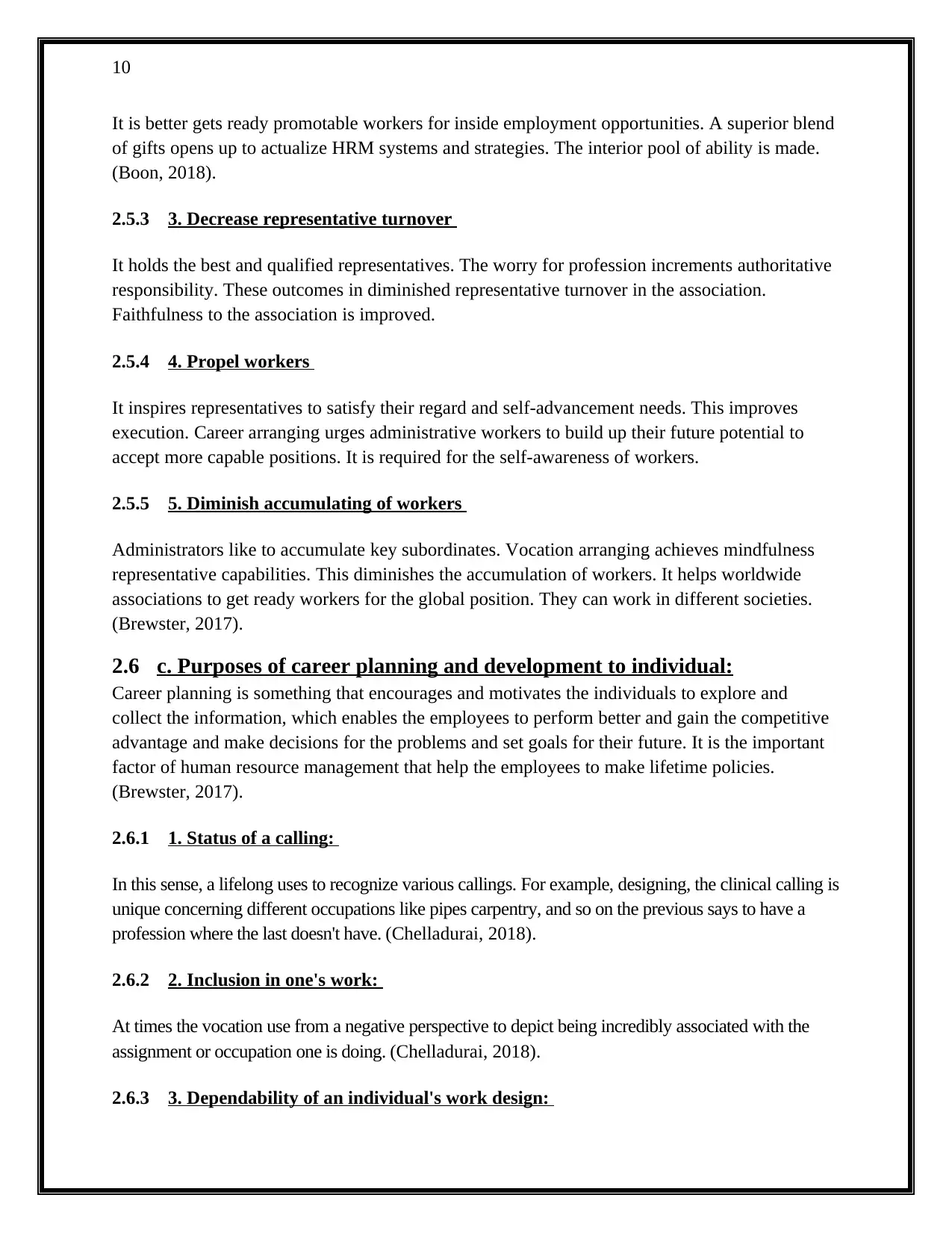
10
It is better gets ready promotable workers for inside employment opportunities. A superior blend
of gifts opens up to actualize HRM systems and strategies. The interior pool of ability is made.
(Boon, 2018).
2.5.3 3. Decrease representative turnover
It holds the best and qualified representatives. The worry for profession increments authoritative
responsibility. These outcomes in diminished representative turnover in the association.
Faithfulness to the association is improved.
2.5.4 4. Propel workers
It inspires representatives to satisfy their regard and self-advancement needs. This improves
execution. Career arranging urges administrative workers to build up their future potential to
accept more capable positions. It is required for the self-awareness of workers.
2.5.5 5. Diminish accumulating of workers
Administrators like to accumulate key subordinates. Vocation arranging achieves mindfulness
representative capabilities. This diminishes the accumulation of workers. It helps worldwide
associations to get ready workers for the global position. They can work in different societies.
(Brewster, 2017).
2.6 c. Purposes of career planning and development to individual:
Career planning is something that encourages and motivates the individuals to explore and
collect the information, which enables the employees to perform better and gain the competitive
advantage and make decisions for the problems and set goals for their future. It is the important
factor of human resource management that help the employees to make lifetime policies.
(Brewster, 2017).
2.6.1 1. Status of a calling:
In this sense, a lifelong uses to recognize various callings. For example, designing, the clinical calling is
unique concerning different occupations like pipes carpentry, and so on the previous says to have a
profession where the last doesn't have. (Chelladurai, 2018).
2.6.2 2. Inclusion in one's work:
At times the vocation use from a negative perspective to depict being incredibly associated with the
assignment or occupation one is doing. (Chelladurai, 2018).
2.6.3 3. Dependability of an individual's work design:
It is better gets ready promotable workers for inside employment opportunities. A superior blend
of gifts opens up to actualize HRM systems and strategies. The interior pool of ability is made.
(Boon, 2018).
2.5.3 3. Decrease representative turnover
It holds the best and qualified representatives. The worry for profession increments authoritative
responsibility. These outcomes in diminished representative turnover in the association.
Faithfulness to the association is improved.
2.5.4 4. Propel workers
It inspires representatives to satisfy their regard and self-advancement needs. This improves
execution. Career arranging urges administrative workers to build up their future potential to
accept more capable positions. It is required for the self-awareness of workers.
2.5.5 5. Diminish accumulating of workers
Administrators like to accumulate key subordinates. Vocation arranging achieves mindfulness
representative capabilities. This diminishes the accumulation of workers. It helps worldwide
associations to get ready workers for the global position. They can work in different societies.
(Brewster, 2017).
2.6 c. Purposes of career planning and development to individual:
Career planning is something that encourages and motivates the individuals to explore and
collect the information, which enables the employees to perform better and gain the competitive
advantage and make decisions for the problems and set goals for their future. It is the important
factor of human resource management that help the employees to make lifetime policies.
(Brewster, 2017).
2.6.1 1. Status of a calling:
In this sense, a lifelong uses to recognize various callings. For example, designing, the clinical calling is
unique concerning different occupations like pipes carpentry, and so on the previous says to have a
profession where the last doesn't have. (Chelladurai, 2018).
2.6.2 2. Inclusion in one's work:
At times the vocation use from a negative perspective to depict being incredibly associated with the
assignment or occupation one is doing. (Chelladurai, 2018).
2.6.3 3. Dependability of an individual's work design:
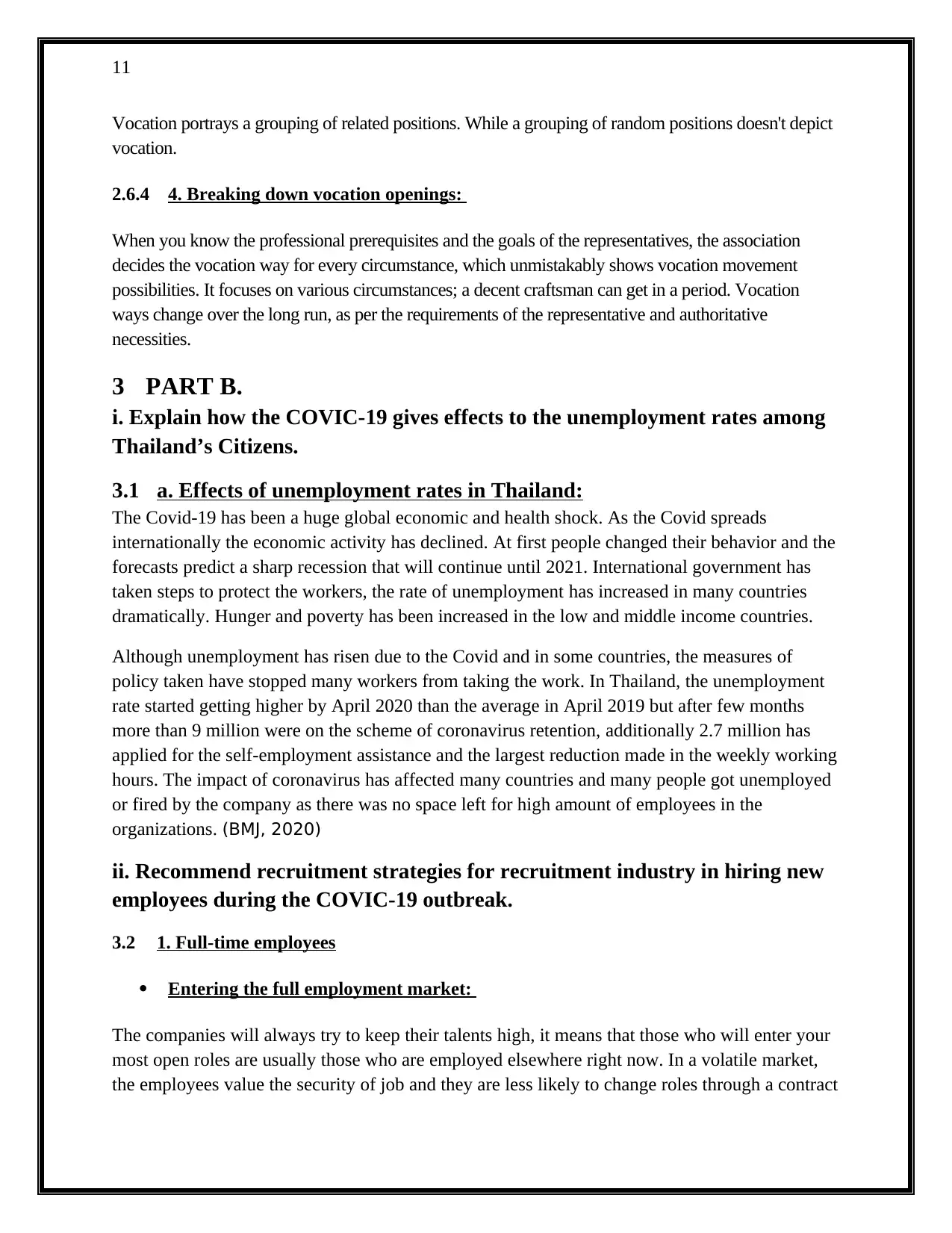
11
Vocation portrays a grouping of related positions. While a grouping of random positions doesn't depict
vocation.
2.6.4 4. Breaking down vocation openings:
When you know the professional prerequisites and the goals of the representatives, the association
decides the vocation way for every circumstance, which unmistakably shows vocation movement
possibilities. It focuses on various circumstances; a decent craftsman can get in a period. Vocation
ways change over the long run, as per the requirements of the representative and authoritative
necessities.
3 PART B.
i. Explain how the COVIC-19 gives effects to the unemployment rates among
Thailand’s Citizens.
3.1 a. Effects of unemployment rates in Thailand:
The Covid-19 has been a huge global economic and health shock. As the Covid spreads
internationally the economic activity has declined. At first people changed their behavior and the
forecasts predict a sharp recession that will continue until 2021. International government has
taken steps to protect the workers, the rate of unemployment has increased in many countries
dramatically. Hunger and poverty has been increased in the low and middle income countries.
Although unemployment has risen due to the Covid and in some countries, the measures of
policy taken have stopped many workers from taking the work. In Thailand, the unemployment
rate started getting higher by April 2020 than the average in April 2019 but after few months
more than 9 million were on the scheme of coronavirus retention, additionally 2.7 million has
applied for the self-employment assistance and the largest reduction made in the weekly working
hours. The impact of coronavirus has affected many countries and many people got unemployed
or fired by the company as there was no space left for high amount of employees in the
organizations. (BMJ, 2020)
ii. Recommend recruitment strategies for recruitment industry in hiring new
employees during the COVIC-19 outbreak.
3.2 1. Full-time employees
Entering the full employment market:
The companies will always try to keep their talents high, it means that those who will enter your
most open roles are usually those who are employed elsewhere right now. In a volatile market,
the employees value the security of job and they are less likely to change roles through a contract
Vocation portrays a grouping of related positions. While a grouping of random positions doesn't depict
vocation.
2.6.4 4. Breaking down vocation openings:
When you know the professional prerequisites and the goals of the representatives, the association
decides the vocation way for every circumstance, which unmistakably shows vocation movement
possibilities. It focuses on various circumstances; a decent craftsman can get in a period. Vocation
ways change over the long run, as per the requirements of the representative and authoritative
necessities.
3 PART B.
i. Explain how the COVIC-19 gives effects to the unemployment rates among
Thailand’s Citizens.
3.1 a. Effects of unemployment rates in Thailand:
The Covid-19 has been a huge global economic and health shock. As the Covid spreads
internationally the economic activity has declined. At first people changed their behavior and the
forecasts predict a sharp recession that will continue until 2021. International government has
taken steps to protect the workers, the rate of unemployment has increased in many countries
dramatically. Hunger and poverty has been increased in the low and middle income countries.
Although unemployment has risen due to the Covid and in some countries, the measures of
policy taken have stopped many workers from taking the work. In Thailand, the unemployment
rate started getting higher by April 2020 than the average in April 2019 but after few months
more than 9 million were on the scheme of coronavirus retention, additionally 2.7 million has
applied for the self-employment assistance and the largest reduction made in the weekly working
hours. The impact of coronavirus has affected many countries and many people got unemployed
or fired by the company as there was no space left for high amount of employees in the
organizations. (BMJ, 2020)
ii. Recommend recruitment strategies for recruitment industry in hiring new
employees during the COVIC-19 outbreak.
3.2 1. Full-time employees
Entering the full employment market:
The companies will always try to keep their talents high, it means that those who will enter your
most open roles are usually those who are employed elsewhere right now. In a volatile market,
the employees value the security of job and they are less likely to change roles through a contract
⊘ This is a preview!⊘
Do you want full access?
Subscribe today to unlock all pages.

Trusted by 1+ million students worldwide
1 out of 21
Related Documents
Your All-in-One AI-Powered Toolkit for Academic Success.
+13062052269
info@desklib.com
Available 24*7 on WhatsApp / Email
![[object Object]](/_next/static/media/star-bottom.7253800d.svg)
Unlock your academic potential
Copyright © 2020–2025 A2Z Services. All Rights Reserved. Developed and managed by ZUCOL.



